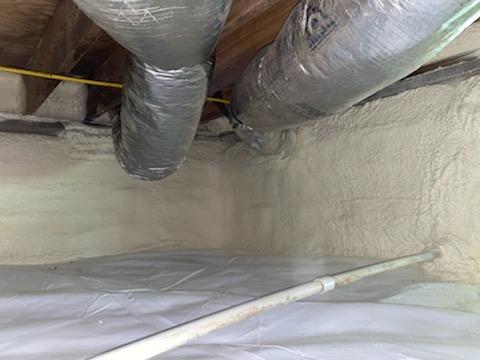Before & After Photos
Click on a photo to enlarge.
Installing a Crawl Space Vapor Barrier in Sandston, VA
These homeowners in Sandston, VA were concerned about moisture in their crawl space. Many areas of the crawl space dirt floor were exposed and efflorescence covered the porous block walls. To address the moisture issues from the foundation walls, we installed a 10-mil CleanSpace Vapor Barrier. This crawl space liner is installed over the crawl space floor, wrapped around each pier, and mechanically attached to the foundation walls above the outside grade. This will help protect the crawl space from the earth’s moisture.
Utility lines in crawl space in New Kent, VA
Utility lines in a vented crawl space are often affected by outside air carrying in moisture. Sealing vents, installing the CleanSpace Encapsulation System and insulating the crawl space walls with Spray Foam will help control the flow of air carrying moisture into the crawl space.
Mold in New Kent, VA Crawl Space
As the insulation acts as a sponge, it holds moisture against the wood joists raising the moisture content of the joists. Mold requires organic material, warm temperatures, and relative humidity above 60% to grow. Often we see mold growing on the paper backing of the insulation and on wood joists in the crawl space. As the moisture content in the joists increases, the probability for wood rot becomes more likely. Once the joists reach 19% moisture wood rot begins. An antimicrobial called Shockwave is sprayed onto the joists to kill the mold. Once the encapsulation is complete and the dehumidifier is installed it will be set to turn on before the humidity in the crawl space reaches 60% (The ideal point for mold to grow). The Encapsulation system will help prevent ideal conditions for mold to grow from occurring and make the home healthier and more comfortable.
Crawl Space Encapsulation in Bruington, VA
This Bruington, VA client contacted us about repairing moisture damage in their crawl space. Moisture had caused mold and mildew growth, was absorbed in the insulation which held it against the floor joists, the material began to delaminate and fall away from the floor.
All debris and insulation was removed from the crawl space, microbial growth was treated, the vents, sill plate, & rim band were sealed, the foundation walls were insulated with closed cell spray foam insulation and a dehumidifier was installed to control the relative humidity. The homeowners no longer need to worry about moisture damage in their crawl space and have the added benefit of warmer floors in the winter and reduced drafts in the home.
Spray Foam on Foundation Walls - Toano, VA
Before: The foundation walls of this crawl space are created with porous cinderblocks, meaning they let water vapor seep through. Without proper encapsulation, the relative humidity is out of the homeowner’s control. During the wetter seasons, the ground outside the home is soaked with water each time it rains and eventually the moisture will find its way through these porous foundation walls, causing the relative humidity in the crawl space to rise with the temperature.
After: The foundation walls of the crawl space in this picture have been covered and sealed with closed-cell spray foam. The moisture is no longer able to access the crawl space through the walls due to the foam sealing over the vapor barrier. The closed-cell foam becomes an air barrier and vapor retarder if sprayed to 1.5” or more. This solution will assist in keeping the relative humidity under control by blocking water vapor from the ground outside to enter, stopping mold or mildew from growing on any organic materials by cutting out the moisture they need to thrive.












